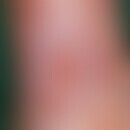Synonym(s)
HistoryThis section has been translated automatically.
DefinitionThis section has been translated automatically.
Nevoid cystic adnexal tumors with sebaceous gland differentiation. Steatocystoma multiplex may occur in association with multiple vellus hair cysts as well as pachyonychia congenita, both of which may share the same genetic defect.
You might also be interested in
EtiopathogenesisThis section has been translated automatically.
Autosomal-dominantly inherited mutation of the gene KRT17, which is mapped on the gene locus 17q12-q21, with consecutive disturbance of keratin 17. In such cases, other developmental anomalies of the tissues derived from the ectoderm may occur simultaneously, such as on nails, hair and teeth (see Fig).
Pathogenetically, there is an enlargement of sebaceous gland follicles with rudimentary sebaceous gland infundibulum without continuous connection to the skin surface. A closed sterile cyst develops from the underlying sebaceous gland acini, ducts and hair systems, so that there is usually no inflammation.
Only in the clinical picture of Steatocystoma multiplex conglobatum chronic inflammatory processes are observed. In this case, clinical forms can develop as in hidradenitis suppurativa (Alotaibi L et al. 2019).
In addition to autosomal dominant inheritance, sporadic forms of steatocystoma multiplex also occur (Jiang M et al. 2020).
ManifestationThis section has been translated automatically.
LocalizationThis section has been translated automatically.
Especially the chest, armpits and back are affected. Rarely also appearing on the forehead or scrotum.
ClinicThis section has been translated automatically.
HistologyThis section has been translated automatically.
Differential diagnosisThis section has been translated automatically.
Complication(s)(associated diseasesThis section has been translated automatically.
TherapyThis section has been translated automatically.
Note(s)This section has been translated automatically.
LiteratureThis section has been translated automatically.
- Alotaibi L et al (2019) Steatocystoma Multiplex Suppurativa: A Case with Unusual Giant Cysts over the Scalp and Neck. Case Rep Dermatol 11:71-76.
- Cho S et al (2002) Clinical and histologic features of 64 cases of steatocystoma multiplex. J Dermatol 29: 152-156
- Jamieson WA (1873) Case of numerous cutaneous cysts scattered over the body. Edin Med J 19: 223-225
- Rollins T et al (2000) Acral steatocystoma multiplex. J Am Acad Dermatol 43: 396-369
- Rongioletti F et al (2002) Late onset vulvar steatocystoma multiplex. Clin Exp Dermatol 27: 445-447
- Rossi R et al (2003) CO2 laser therapy in a case of steatocystoma multiplex with prominent nodules on the face and neck. Int J Dermatol 42: 302-304
- Sardana K et al (2002) Facial steatocystoma multiplex associated with pilar cyst and bilateral preauricular sinus. J Dermatol 29: 157-159
- Schmook T (2001) Surgical pearl: mini-incisions for the extraction of steatocystoma multiplex. J Am Acad Dermatol 44: 1041-1042.
- Shin NY et al (2019) Steatocystoma multiplex: A case report of a rare entity. Imaging Sci Dent 49:317-321.
Incoming links (15)
Cyst; Epidermal cyst; Keratin; KRT17 Gene; Nasal fistula and cyst, congenital; Pachyonychia congenita; Pili torti; Sebaceous cysts; Sebocystomatosis günther; Steatocystoma; ... Show allOutgoing links (10)
Acne cystica; Cyst; Isotretinoin; Komedo; KRT17 Gene; Pachyonychia congenita; Steatocystoma multiplex conglobatum; Stratum granulosum; Trichilemmal cyst; Vellus hair cysts eruptive;Disclaimer
Please ask your physician for a reliable diagnosis. This website is only meant as a reference.










